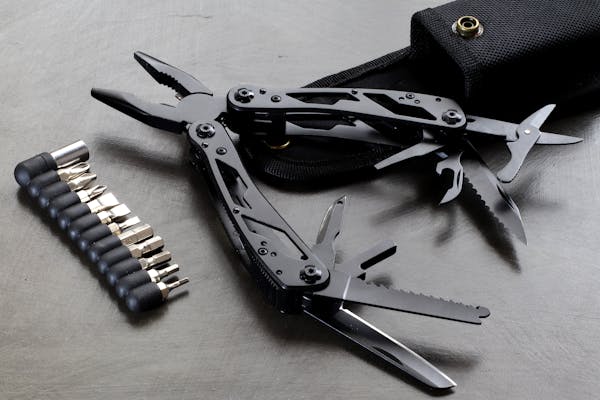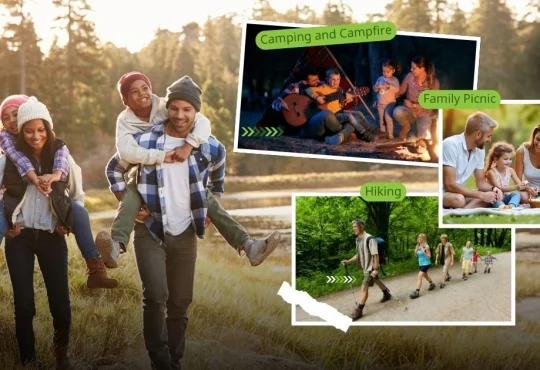Outdoor adventures, whether for hiking, camping, backpacking, or hunting, require careful preparation to ensure both enjoyment and safety. A key aspect of any well-planned expedition is packing the right outdoor survival equipment. This gear is more than just an assortment of tools—it’s the foundation of your ability to navigate challenges, respond to unexpected situations, and thrive in the wilderness. From extreme weather to unpredictable terrain, being well-equipped can make the difference between a great adventure and a disaster.
In this comprehensive guide, we’ll explore the essential outdoor survival equipment that every adventurer should consider. Whether you’re a seasoned explorer or new to outdoor activities, this list will help you pack effectively, ensuring you’re prepared for whatever nature throws your way.

Navigation Tools
One of the most crucial components of outdoor survival equipment is a reliable means of navigation. Being able to find your way in the wilderness can prevent getting lost—a situation that can quickly escalate into a serious emergency.
1. Map and Compass
A topographic map and compass remain one of the most trustworthy and lightweight navigation tools. While GPS systems can fail due to signal loss or dead batteries, a map and compass work reliably under all conditions. Learning how to read maps and navigate using a compass is a fundamental skill for any outdoor adventurer.
2. GPS Device
A GPS (Global Positioning System) unit is a valuable tool to complement your map and compass. Modern handheld GPS units are designed for outdoor use, offering highly detailed mapping features, weather alerts, and route tracking. Some units even allow for satellite communication in case of emergencies. Always pack extra batteries for extended trips.
3. Smartphone with Offline Maps
Many hikers and campers use smartphones for navigation, but relying solely on a phone isn’t advisable. However, there are apps that allow you to download offline maps in case you lose signal. Be mindful of battery life and bring along a portable charger if you intend to use your phone as a navigational aid.
Shelter and Sleeping Gear
Nature can be unpredictable, and weather conditions can change rapidly. Proper shelter and sleeping gear are vital components of outdoor survival equipment, ensuring you stay dry, warm, and well-rested.
1. Tent or Tarp
A lightweight, durable tent is an essential piece of survival equipment. Choose a model that suits your environment and climate—whether it’s a three-season tent for moderate conditions or a four-season tent for extreme cold and wind. Alternatively, a survival tarp is a great lightweight option for creating quick shelter, especially in emergencies.
2. Sleeping Bag
A high-quality sleeping bag rated for the temperatures you expect to encounter is essential. In colder climates, a down-filled bag provides superior insulation, while synthetic bags are better for wet conditions. It’s important to note the temperature ratings and opt for a bag that will keep you warm, even in the most frigid nights.
3. Sleeping Pad
A sleeping pad serves two purposes: comfort and insulation from the ground. Sleeping directly on the ground can cause your body to lose heat, even if you’re inside a sleeping bag. Inflatable or foam sleeping pads are lightweight and provide much-needed insulation.
Fire-Starting Tools
The ability to start a fire is a cornerstone of survival. Fire provides warmth, the ability to cook food, and psychological comfort in difficult situations. Thus, fire-starting tools are critical outdoor survival equipment.
1. Waterproof Matches and Lighters
Always carry waterproof matches and a reliable lighter. Stormproof matches are designed to light even in extreme weather conditions such as high winds and rain. Similarly, windproof and refillable lighters are durable and dependable for any adventure.
2. Fire Starter
In addition to matches and a lighter, carry a fire starter. Ferrocerium rods (ferro rods) are a popular choice among survivalists. These tools produce hot sparks when struck with a metal object, allowing you to ignite dry tinder quickly, even if the environment is wet or cold.
3. Tinder
Pack some fire-starting tinder in a waterproof container, especially if you’re heading into areas where natural dry tinder may be difficult to find. Cotton balls soaked in petroleum jelly, commercial fire-starting tabs, or even dryer lint work well as emergency tinder.
Water Purification and Hydration Systems
Water is essential for survival, but not all water sources are safe to drink. Being able to purify water is an important part of your outdoor survival equipment. Dehydration can set in quickly, and drinking contaminated water can cause severe illness.
1. Water Bottle or Hydration Bladder
A durable water bottle or hydration bladder allows you to carry enough water for your trip. Many outdoor adventurers prefer hydration bladders because they are lightweight and provide easy access to water without having to stop and reach for a bottle.
2. Water Filtration System
A portable water filtration system, such as a pump filter or gravity-fed filter, enables you to purify water from natural sources like rivers and lakes. These systems remove harmful bacteria, protozoa, and sediments, providing safe drinking water in the wilderness.
3. Water Purification Tablets
For emergencies or when traveling light, water purification tablets are a compact and easy-to-use alternative to a filter. Tablets are effective at killing bacteria, viruses, and other microorganisms. Be sure to follow instructions carefully to ensure proper disinfection.
4. Collapsible Water Container
For longer trips or when camping at a base camp, having a collapsible water container allows you to store larger amounts of purified water. This can be especially useful when water sources are scarce or far from your campsite.
Food and Cooking Gear
Staying nourished and maintaining energy levels is critical during outdoor adventures. Your outdoor survival equipment should include tools and supplies for preparing meals in the wilderness.
1. Lightweight Stove
A compact, lightweight stove is a must-have for outdoor cooking, especially in areas where campfires are restricted. A canister stove or wood-burning stove works well, offering efficient cooking in a variety of conditions. Be sure to bring enough fuel for the duration of your trip.
2. Freeze-Dried Meals and Snacks
Freeze-dried meals are lightweight, have a long shelf life, and are easy to prepare with boiling water. These meals provide the necessary calories and nutrients for sustained energy during outdoor activities. In addition to freeze-dried meals, pack energy bars, nuts, and dried fruit for quick snacks on the go.
3. Mess Kit and Utensils
A basic mess kit should include a pot for boiling water, a cup, and utensils for eating. Stainless steel or aluminum kits are lightweight and durable, making them ideal for outdoor cooking. Collapsible utensils and bowls can save space in your pack.
4. Bear Canister (If Needed)
In areas where bears or other wildlife are present, it’s important to store food properly. Bear canisters are designed to be wildlife-proof, keeping your food secure and preventing animals from accessing it. They also reduce the risk of attracting wildlife to your campsite.
Clothing and Footwear
Appropriate clothing and footwear are key to maintaining comfort and safety in the outdoors. Dressing in layers and choosing the right materials can protect you from the elements and keep you dry and warm.
1. Layered Clothing System
A proper layering system includes a moisture-wicking base layer, an insulating mid-layer, and a waterproof outer layer. Wool or synthetic base layers are ideal because they wick sweat away from the skin and dry quickly. Fleece or down jackets provide warmth in colder conditions, while a waterproof jacket and pants protect against rain and wind.
2. Durable Footwear
Choosing the right footwear depends on the type of terrain you’ll encounter. Hiking boots with sturdy soles and ankle support are essential for rocky or uneven terrain, while lighter trail shoes may be more appropriate for well-maintained paths. Always break in your boots before a long trip to prevent blisters.
3. Extra Clothing
Always carry extra socks, underwear, and a hat for warmth. Even if you don’t expect cold weather, temperatures can drop unexpectedly at night or in higher elevations. Wool socks and a warm hat can make a big difference in maintaining body heat.
First Aid Kit and Emergency Supplies
Even on a well-planned adventure, accidents can happen. A well-stocked first aid kit and other emergency supplies are crucial elements of outdoor survival equipment.
1. First Aid Kit
Your first aid kit should include basics like bandages, antiseptic wipes, adhesive tape, and gauze for treating minor cuts and wounds. It’s also important to have items for blister care, tweezers for splinter removal, and any personal medications you may need. Adventure-specific first aid kits are designed for outdoor use and contain supplies for common injuries in the wilderness.
2. Emergency Blanket
An emergency blanket, also known as a space blanket, is a compact and lightweight item that reflects body heat and helps prevent hypothermia. It can be used in emergencies to stay warm, signal for help, or create an improvised shelter.
3. Multi-Tool
A multi-tool is one of the most versatile pieces of outdoor survival equipment. It typically includes pliers, knives, screwdrivers, scissors, and more, making it useful for a variety of tasks, from repairs to food preparation.
4. Whistle and Signal Mirror
In case of an emergency where you need to signal for help, a whistle and signal mirror are essential. A whistle can be heard over long distances, while a mirror can reflect sunlight to attract attention from rescuers.
5. Paracord
Paracord, or parachute cord, is an extremely strong and versatile material that can be used for building shelters, repairing gear, or hanging food. Carry at least 50 feet of paracord as part of your survival gear.
Lighting and Power Sources
When the sun sets, having a reliable source of light is critical for navigating and setting up camp. Your outdoor survival equipment should include lighting tools and backup power sources.
1. Headlamp
A headlamp is a hands-free way to light your path or work around camp in the dark. Choose a headlamp with multiple brightness settings and a red light mode to preserve night vision. Make sure to bring extra batteries or a rechargeable battery pack.
2. Backup Flashlight
In addition to a headlamp, it’s a good idea to pack a small flashlight as a backup. LED flashlights are lightweight and provide strong, reliable illumination. As with any battery-powered device, carry extra batteries to ensure your light doesn’t fail when you need it most.
3. Solar Charger or Portable Power Bank
If you’re carrying electronic devices like GPS units, phones, or cameras, a portable power bank or solar charger is essential for keeping them charged during extended trips. Solar chargers are especially useful for long adventures where electricity is not available.
Tools for Safety and Defense
When venturing into remote areas, it’s important to carry tools that can protect you from potential threats, whether they be wildlife or environmental hazards.
1. Bear Spray
If you’re adventuring in bear country, bear spray is one of the most effective ways to deter a charging bear. Bear spray contains powerful capsicum that can stop a bear in its tracks, providing you with time to safely retreat.
2. Survival Knife
A sturdy survival knife is one of the most essential tools you can carry. It can be used for a wide range of tasks, from cutting rope and preparing food to building shelter and defending yourself. Fixed-blade knives are preferred for their strength and durability.
3. Personal Locator Beacon (PLB)
For ultimate safety, especially when traveling in remote areas without cell service, consider carrying a Personal Locator Beacon (PLB). In case of a life-threatening emergency, a PLB sends a distress signal to search and rescue teams via satellite, ensuring help can reach you even in the most isolated locations.
When planning an outdoor adventure, having the right survival equipment can make the difference between a safe, enjoyable experience and a dangerous situation. By carefully selecting and packing essential gear like navigation tools, shelter, fire-starting tools, water filtration, first aid supplies, and emergency devices, you can confidently face the challenges of the wilderness.
Whether you’re embarking on a short hike or a multi-day expedition, the outdoor survival equipment mentioned in this guide will ensure you’re prepared for whatever nature throws your way. Equip yourself wisely, and your outdoor adventure will be safer, more comfortable, and far more enjoyable.





